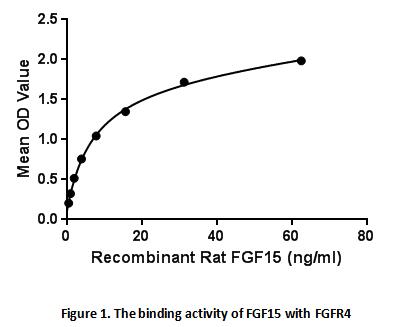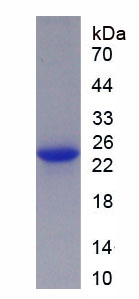Active Fibroblast Growth Factor 15 (FGF15) 

- UOM
- FOB US$ 310.00 US$ 774.00 US$ 1,548.00 US$ 4,644.00 US$ 11,610.00
- Quantity
Overview
Properties
- Product No.APL154Ra01
- Organism SpeciesRattus norvegicus (Rat) Same name, Different species.
- ApplicationsCell culture; Activity Assays.
Research use only - DownloadInstruction Manual
- CategoryHuman gene deletion
- Buffer FormulationPBS, pH7.4, containing 0.01% SKL, 1mM DTT, 5% Trehalose and Proclin300.
- Traits Freeze-dried powder, Purity > 90%
- Isoelectric Point6.6
Sign into your account
Share a new citation as an author
Upload your experimental result
Review

Contact us
Please fill in the blank.
Activity test

Fibroblast growth factor 15 is a protein in mouse encoded by the Fgf15 gene. It is a member of the fibroblast growth factor (FGF) family but, like FGF19, FGF21 and FGF23, has endocrine functions. FGF15 subsequently acts on a cell surface receptor complex in hepatocytes to repress bile acid synthesis and gluconeogenesis, and to stimulate glycogen and protein synthesis.Besides, Fibroblast Growth Factor Receptor 4 (FGFR4) has been identified as an interactor of FGF15, thus a binding ELISA assay was conducted to detect the interaction of recombinant rat FGF15 and recombinant rat FGFR4. Briefly, FGF15 were diluted serially in PBS, with 0.01% BSA (pH 7.4). Duplicate samples of 100μl then transferred to FGFR4-coated microtiter wells and incubated for 2h at 37℃. Wells were washed with PBST and incubated for 1h with anti-FGF15 pAb, then aspirated and washed 3 times. After incubation with HRP labelled secondary antibody, wells were aspirated and washed 3 times. With the addition of substrate solution, wells were incubated 15-25 minutes at 37℃. Finally, add 50µl stop solution to the wells and read at 450nm immediately. The binding activity of FGF15 and FGFR4 was shown in Figure 1, and this effect was in a dose dependent manner.
Usage
Reconstitute in 10mM PBS (pH7.4) to a concentration of 0.1-1.0 mg/mL. Do not vortex.
Storage
Avoid repeated freeze/thaw cycles. Store at 2-8°C for one month. Aliquot and store at -80°C for 12 months.
Stability
The thermal stability is described by the loss rate. The loss rate was determined by accelerated thermal degradation test, that is, incubate the protein at 37°C for 48h, and no obvious degradation and precipitation were observed. The loss rate is less than 5% within the expiration date under appropriate storage condition.
Increment services
-
 BCA Protein Quantification Kit
BCA Protein Quantification Kit
-
 Molecular Mass Marker for Protein
Molecular Mass Marker for Protein
-
 Monoclonal Antibody Customized Service
Monoclonal Antibody Customized Service
-
 Polyclonal Antibody Customized Service
Polyclonal Antibody Customized Service
-
 Protein Activity Test Experiment Service
Protein Activity Test Experiment Service
-
 Electrophoretic Mobility Shift Assay (EMSA) Experiment Service
Electrophoretic Mobility Shift Assay (EMSA) Experiment Service
-
 Buffer
Buffer
-
 Lentivirus Packaging Experiment Service
Lentivirus Packaging Experiment Service
-
 Adenovirus Packaging Experiment Service
Adenovirus Packaging Experiment Service
-
 Real Time PCR Experimental Service
Real Time PCR Experimental Service
-
 Spike RBD Protein (S-RBD)
Spike RBD Protein (S-RBD)
-
 Protein G
Protein G
-
 Protein A
Protein A
Citations
- Naringenin Prevents Obesity, Hepatic Steatosis, and Glucose Intolerance in Male Mice Independent of Fibroblast Growth Factor 21PubMed: 25774553
- Alterations in Enterohepatic Fgf15 Signaling and Changes in Bile Acid Composition Depend on Localization of Murine Intestinal Inflammationpubmed:27580383
- Commensal bacteria at the crossroad between cholesterol homeostasis and chronic inflammation in atherosclerosis.pubmed:28130274
- The relationship between bile acid concentration, glucagon-like-peptide 1, fibroblast growth factor 15 and bile acid receptors in rats during progression of glucose intolerance10.1186/s12902-017-0211-5
- The ileal FGF15/19 to hepatic FGFR4 axis regulates liver regeneration after partial hepatectomy in micePubmed:29468415
- FGF15 Activates Hippo Signaling to Suppress Bile Acid Metabolism and Liver TumorigenesisPubmed: 30745141
- Interactions between the gravitostat and the fibroblast growth factor system for the regulation of body weight
- Lactoferrin promotes bile acid metabolism and reduces hepatic cholesterol deposition by inhibiting the farnesoid X receptor (FXR)-mediated enterohepatic axisPubmed: 31626262
- Gut microbiota from coronary artery disease patients contributes to vascular dysfunction in mice by regulating bile acid metabolism and immune activationPubmed: 33036625
- Si-Wu-Tang ameliorates fibrotic liver injury via modulating intestinal microbiota and bile acid homeostasis34736501
- Dynamics of the gut-liver axis in rats with varying fibrosis severityPubmed:35637968







